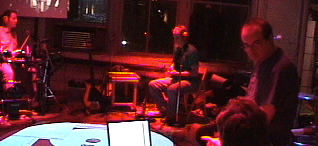AudioPint status update
At SIGGRAPH, we had 6 performers on stage, each using a PureJoy connected to a single AudioPint (that is, 6 PureJoy's, 1 AudioPint total). So a single VIA motherboard with 512MB of RAM was supporting recording/sampling, looping, effects and scrubbing for 6 performers simultaneously! That was impressive. (thanks to VIA for providing us with motherboards - they rock!) We moved up to an EPIA SP13000 from an SP8000 (the 8000 is a lower-power, fanless motherboard whereas the 13000 is faster and has a CPU fan) after finding that we would max out the 8000's processing capabilities when multiple people started using effects at the same time. Reverb, though nice, is a particularly costly operation since it requires a running convolution, hence the need for the faster board.
What's next? Then plan is to build a set of more powerful AudioPints with wireless, both WiFi for communication with other AudioPints, and wireless input (perhaps Bluetooth) for control and audio. Wireless input will free up a performer on stage to run around and entertain the crowd during a show. The InventMusic crew will continue to perform with the AudioPints, and we'd also like to get them into the hands of some professional musicians, to get more feedback about their design.
Here's a picture of AudioPint under heavy development, and the intense cableage that results!
-Dave






0 Comments:
Post a Comment
<< Home